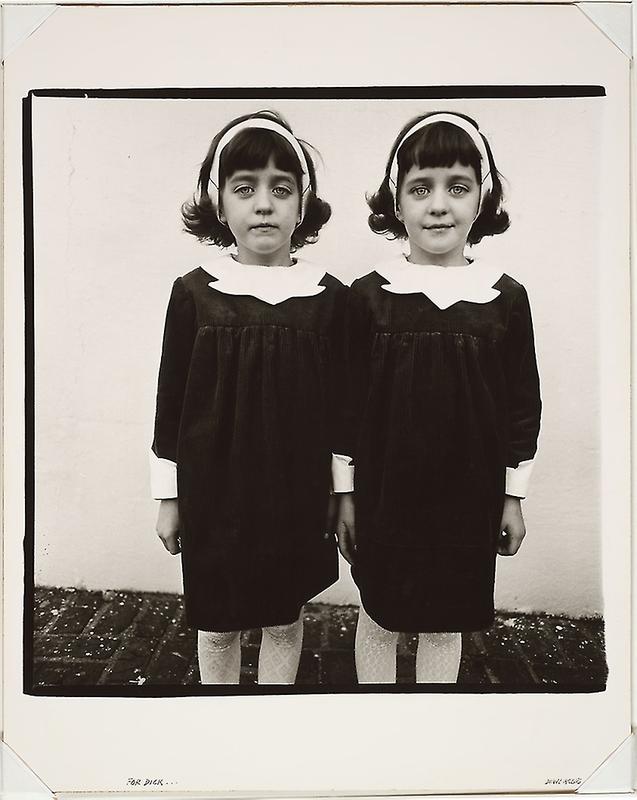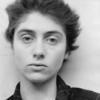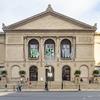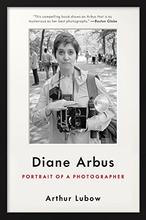More about Identical Twins, Roselle, New Jersey
- All
- Info
- Shop

Contributor
Identical Twins, Roselle, New Jersey, 1967 is a record of an encounter between Arbus and two seven-year-olds, Cathleen and Colleen, against a wall of the local hall of the Knights of Columbus, a fraternal organization of the Catholic church.
As of 2003, the twins still own the dresses, and they don't remember the shoot. "We've always been baffled that she made them look ghostly. None of the other pictures we have of them looks anything like this," says the twins' father, Bob Wade. The photo is on the cover of Arbus's first book of photos, and it reminds Cathleen of her daughter.
"I thought how ordinary is a charming pair of twins," Arbus said about the work. "In some societies, twins are taboo, an aberration." This was part of Arbus's endless fascination with "freaks," a term that is no longer kosher in the US but describes something that still exists: certain people who know that they'll always be outsiders. Dressing Cathleen and Colleen in identical clothes, their parents knew that this wardrobe decision was emphasizing, not downplaying, their social exclusion, their status as biological anomalies.
Placing the daughters together, their dresses touching, Arbus does everything possible to increase both our awe at the sight of these medically unusual children, and our shame at our belated recognition of our own tendency to gawk at people, especially when the people themselves can't see us. The effect she gives us is an instance of the "mixture of shame and awe" that she sought in her own photographic encounters with people on the margins. The critic Frederick Gross writes, "these are identical twins as the mythology of twins leads us to believe them to be—odd and slightly mystical, sharing secrets and thoughts."
"This photographing,” Arbus said, “is really the business of stealing.” It involves appropriating a person's time and likeness, but also some kind of spiritual aspect, the outsider model's resignation, "aristocratic," as Arbus called it, to always being an outsider. The twins, in Arbus's words, are "born with" the trauma of being unusual, and have therefore "passed the test" avoided by nearly everyone in life, the test of adversity. An adverse part of Arbus's own childhood, she said ironically but very sadly, was an apparent lack of adversity in her own life, disregarding her parents' decision to outsource her upbringing to childcare workers, her surrogate parents.
Sources
- Adatto, Kiku. Picture Perfect: The Art And Artifice Of Public Image Making. New York: Basic Books, 1994.
- Bosworth, Patricia. Diane Arbus: A Biography. New York: Open Road Media, 2012.
- Dillon, Karen. The Spectacle of Twins in American Literature and Popular Culture. Jefferson, NC: McFarland, 2018.
- Gross, Frederick. Diane Arbus's 1960s: Auguries of Experience. Minneapolis: University of Minnesota Press, 2012.
- Mar, Alex. "Was Diane Arbus the Most Radical Photographer of the 20th Century?" The Cut, 2016, https://www.thecut.com/2016/07/diane-arbus-c-v-r.html.
- Nelson, Deborah. Tough Enough: Arbus, Arendt, Didion, McCarthy, Sontag, Weil. Chicago: University of Chicago Press, 2017.
- Quyen, Christopher. "Homage to Sandro Miller." Capture, Sep. 12, 2018, http://www.capturemag.com.au/profiles/homage-to-sandro-miller.
Featured Content
Here is what Wikipedia says about Identical Twins, Roselle, New Jersey, 1967

Identical Twins, Roselle, New Jersey, 1967 is a noted photograph by photographer Diane Arbus from the United States.
Since its debut Identical twins, Roselle, N. J., has become the image most closely associated with her large body of work. The photograph was chosen as the cover illustration for what was, for many years, Arbus’s only retrospective monograph: Diane Arbus, published by Aperture in 1972. Embodying a culmination of the strongest themes in her work – her fascinations with children, aberrance, and identity, among them – this signature image has never lost its power to engage.
Check out the full Wikipedia article about Identical Twins, Roselle, New Jersey, 1967













